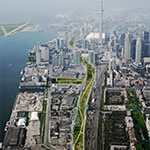A behemoth of midcentury structural engineering, Toronto’s Gardiner Expressway perches high on aging steel columns, carrying a daily blur of high-speed traffic along the lakefront. But on just one day each year, during the Ride for Heart fundraiser, the Gardiner closes to cars and gives cyclists exclusive access to its beeline into the city’s heart. It was on one of these bike rides, in 2008, that Les Klein came up with the idea of a park that is actually a roof. And not just any roof, but one that sits right on top of the highway.
“I’m an architect, so I have about a hundred ideas a day,” says Klein, who founded Quadrangle Architects in 1986. “But the more I examined this one, the more it made sense.”

The Gardiner Green Ribbon would create 3.6 million square feet of green roofing for Toronto and heal the eyesore of the city’s massive, outdated expressway.
Many of the structural issues faced by the Gardiner—issues that have caused factions in the city to call for the expressway’s demolition—are weather-related. A covering would protect the road from the elements, reducing corrosive salt and heavy snowplows during the winter. The Gardiner’s east-west orientation is also a safety hazard, with sun glares impairing visibility for commuters. Klein’s elevated park could be an effective sun visor. Covered in plant life, the roof also would reduce heat island effect. “Urban agriculture, too,” Klein says. “Opportunities for display of art. Filming. Charity walks, runs, and rides.” His passion project, the Gardiner Green Ribbon, was born.
Quadrangle Architects has become known for adaptive reuse projects, so reinventing the city’s existing transportation infrastructure is right in Klein’s wheelhouse. “I happen to love the Gardiner as a piece of engineering,” he says. “I love its iconographic history as well. When it was built, it was considered a symbol of progress. It meant that Toronto had finally arrived. But now, after years of benign—or maybe not-so-benign—neglect, it has suffered from no improvement, no maintenance other than the bare minimum, and it looks old and tired.”

Klein’s Green Ribbon would be structurally independent, built around the expressway and supported by columns that also provide access to the park at each major intersection.

The proposed Green Ribbon is structurally independent from the highway, supported by a bridge-like series of columned supports.

The greenway would cover almost half of the expressway’s 11 miles, creating 3.6 million square feet of green roof interspersed with cafes, shops, galleries, and other amenities.
DETAILS
Location Toronto, Ontario
Previous Use Expressway
Status Proposal
Length 4.35 miles
Architect Quadrangle Architects
Structural Engineer Jablonsky Ast & Partner
Because the Gardiner Expressway is already operating at structural capacity, the Green Ribbon would be structurally independent, supported by a bridge-like series of columned supports made accessible by elevators, ramps, and stairs at every major intersection and elevated up to 80 feet. The flora-filled swath would cover nearly half of the Gardiner’s 11 miles, creating 3.6 million square feet of green roof in the process. Bike paths and pedestrian meanders would traverse the landscape, and cafes, shops, galleries, and other amenities might be sprinkled throughout it. A photovoltaic system would provide enough energy to light the ground, expressway, and Green Ribbon levels, as well as melt snow on park paths.
But Klein’s dream isn’t yet a reality—and may never be. Of all proposed options for the Gardiner’s future, interests backing demolition currently hold the most sway. A quantity assessment agency pegged the Green Ribbon’s current cost at $700 to $800 million, which Klein says is half of the cost of demolishing the Gardiner and building a massive surface highway in its place. Despite a lack of major political support, he hasn’t given up. “This is a big idea,” Klein says. “And Toronto, I believe, needs big ideas, but practical ones. We need to show the world how we can reuse our urban infrastructure in a responsible, creative, and proactive way.”
Click through the other four linear parks below.





